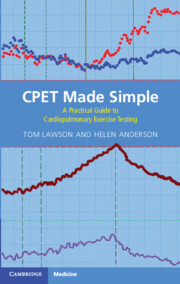Book contents
- CPET Made Simple
- CPET Made Simple
- Copyright page
- Contents
- Glossary
- Abbreviations
- Introduction
- Part I What Is Cardiopulmonary Exercise Testing?
- Part II Conducting a Cardiopulmonary Exercise Test
- Part III Interpreting a Cardiopulmonary Exercise Test
- Chapter 8 Different Plots and CPET Interpretation
- Chapter 9 RER versus Time (or Work Rate) Plot
- Chapter 10 VO2 (and VCO2) versus Work Rate versus Time Plot
- Chapter 11 VCO2 versus VO2 Plot
- Chapter 12 VEVO2 and VEVCO2 versus Time (or Work or VO2) Plot
- Chapter 13 PETO2 and PETCO2 versus Time (or Work or VO2) Plot
- Chapter 14 Heart Rate and O2 Pulse (VO2/HR) versus Time Plot
- Chapter 15 VE versus Time Plot
- Chapter 16 VE versus VCO2 Plot
- Chapter 17 Vt versus VE Plot
- Chapter 18 Additional Parameters of Interest and Presentation of Results
- Part IV Assessment of Exercise Capacity and Causes of Exercise Limitation and Dyspnoea
- Further Reading
- Index
Chapter 8 - Different Plots and CPET Interpretation
from Part III - Interpreting a Cardiopulmonary Exercise Test
Published online by Cambridge University Press: 04 April 2024
- CPET Made Simple
- CPET Made Simple
- Copyright page
- Contents
- Glossary
- Abbreviations
- Introduction
- Part I What Is Cardiopulmonary Exercise Testing?
- Part II Conducting a Cardiopulmonary Exercise Test
- Part III Interpreting a Cardiopulmonary Exercise Test
- Chapter 8 Different Plots and CPET Interpretation
- Chapter 9 RER versus Time (or Work Rate) Plot
- Chapter 10 VO2 (and VCO2) versus Work Rate versus Time Plot
- Chapter 11 VCO2 versus VO2 Plot
- Chapter 12 VEVO2 and VEVCO2 versus Time (or Work or VO2) Plot
- Chapter 13 PETO2 and PETCO2 versus Time (or Work or VO2) Plot
- Chapter 14 Heart Rate and O2 Pulse (VO2/HR) versus Time Plot
- Chapter 15 VE versus Time Plot
- Chapter 16 VE versus VCO2 Plot
- Chapter 17 Vt versus VE Plot
- Chapter 18 Additional Parameters of Interest and Presentation of Results
- Part IV Assessment of Exercise Capacity and Causes of Exercise Limitation and Dyspnoea
- Further Reading
- Index
Summary
The variables that a cardiopulmonary exercise test aims to measure can be presented in a number of different ways. The standard method of presenting these data is as a 9-panel plot. Different 9-panel plots are available; which arrange individual plots in different orientations.
- Type
- Chapter
- Information
- CPET Made SimpleA Practical Guide to Cardiopulmonary Exercise Testing, pp. 53 - 64Publisher: Cambridge University PressPrint publication year: 2024

